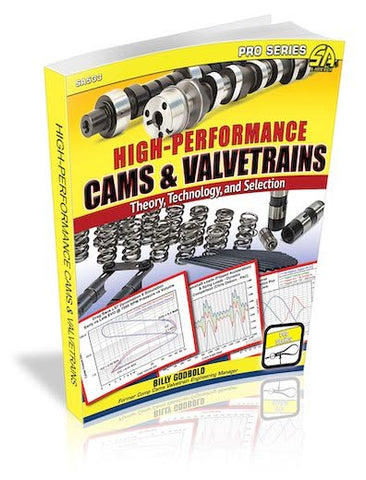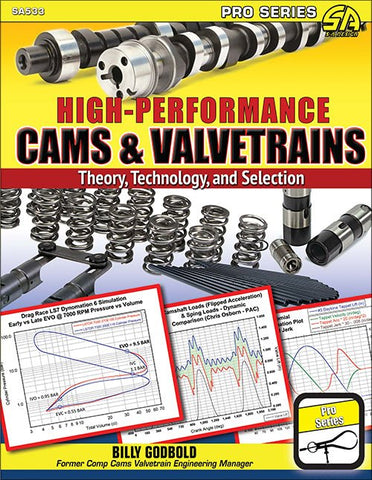Understand the "magic" of how optimized camshafts extract the most performance from every engine component, eliminating valvetrain guesswork.
Camshafts are the coach and conductor of any four-stroke engine from early flatheads to modern Formula 1. Performance engines are amazingly sensitive to how and when the valves to the combustion chamber open and close. The valvetrain configuration and flow characteristics may change significantly between applications, but the fundamental principles are universal. This allows the language, setup, dynamics, energy, and pressure aspects of a valvetrain to be covered in a way that is just as useful for optimizing a sub-15-hp go-kart engine as it is on a 500-plus-hp street engine or a modern 1,500-plus-hp NHRA Pro Stock engine.
In High-Performance Cams and Valvetrains: Theory, Technology, and Selection, farm-kid-turned-physicist Billy Godbold combines his quarter-century of experience with valvetrains at Comp Cams, Lunati, Crane Cams, and Edelbrock with the techniques he uses with professional teams in NASCAR, the NHRA, road racing, dirt-track racing, offshore racing, and land speed racing. He guides you to think about any valvetrain system with his perspective. Often lighthearted and filled with analogies, this book endeavors to make complex concepts easy to understand without watering down important details.
Specific configurations and applications are covered, providing techniques and examples for optimizing camshafts and the valvetrain around intakes, headers, superchargers, turbochargers, fuels, carburetors, and modern EFI applications. If you are planning or building a performance engine, or if you just want to know the science behind how cams and valvetrains work, this book is an indispensable resource.
Chapter 1: The Language of Camshafts
What is a Camshaft?
Basic Terms
Cam Degrees versus Crank Degrees
Intensity
Specification Cards, Comp Adcole Reports, and Published Lobe Data
More on the Specifications Card
Adcole Inspection Report
Chapter 2: Valvetrain Blueprinting
Setting Rocker Height
Setting Lash or Preload
Calculating Optimal Spring Setup Height
Degreeing a Camshaft
Piston-to-Valve Clearance
Advanced Blueprinting
Specific Stiffness
Chapter 3: A Dynamic Understanding of Profiles: Velocity, Acceleration, and Jerk
Velocity
Acceleration
Jerk
Closing Loads Past the Buckling Point
Chapter 4: Energy and Four-Stroke Engine Fundamentals
Follow the Energy
What is Horsepower?
BSFC and Efficiency
The Otto Cycle
Volumetric Efficiency
Chapter 5: Under Pressure
Measured and Theoretical Otto Pressure versus Crank Angle
PV Diagrams
Chapter 6: Understanding Valve Events
EVO
Overlap
IVC
Chapter 7: Wave Tuning
Starting at EVO
Optimizing Intake Port Length
Unequal-Length Intake Runners
Chapter 8: Moving Valve Events
Standard Optimization Techniques
Improved Optimization Techniques
Chapter 9: Camshaft and Cylinder Head Selection
Exhaust to Intake Flow Percentages and Flow Curve Shapes
Cylinder Head Configuration
The Combustion Chamber
CFM per Cubic Inch
Chapter 10: Other Engine Considerations
Bore-to-Stroke Ratios
Rod-to-Stroke Ratios
EFI versus Carbureted
Octane and Other Fuel Considerations
Variable Advance, Centerline, Duration, and/or Lift Systems
Variable Displacement Systems
Power Adders
Valve-Spring Selection with Boost
Thermal Management
Chapter 11: Valvetrain Selection
Camshaft Type
Deciding Target Lift
Selecting Lift and Profiles around the Valve Spring
Rocker Ratio, Journal Size, and Lifter Wheel
RPM and Durability Targets
Comparing Profile Aggressiveness
Optimizing the Camshaft for the Application
Why Do Cam Guys Ask so Much about My Vehicle?
Chapter 12: Camshaft Selection Examples
Small-Block Chevy Crate Upgrades: 350 versus 383
Street versus Racing
GM 5.3L LM7 Cams: C10 pickup to Circle-Track and Drift
6.4L Hemi: Blower and Cam Packages
Glossary
Understand the "magic" of how optimized camshafts extract the most performance from every engine component, eliminating valvetrain guesswork.
Camshafts are the coach and conductor of any four-stroke engine from early flatheads to modern Formula 1. Performance engines are amazingly sensitive to how and when the valves to the combustion chamber open and close. The valvetrain configuration and flow characteristics may change significantly between applications, but the fundamental principles are universal. This allows the language, setup, dynamics, energy, and pressure aspects of a valvetrain to be covered in a way that is just as useful for optimizing a sub-15-hp go-kart engine as it is on a 500-plus-hp street engine or a modern 1,500-plus-hp NHRA Pro Stock engine.
In High-Performance Cams and Valvetrains: Theory, Technology, and Selection, farm-kid-turned-physicist Billy Godbold combines his quarter-century of experience with valvetrains at Comp Cams, Lunati, Crane Cams, and Edelbrock with the techniques he uses with professional teams in NASCAR, the NHRA, road racing, dirt-track racing, offshore racing, and land speed racing. He guides you to think about any valvetrain system with his perspective. Often lighthearted and filled with analogies, this book endeavors to make complex concepts easy to understand without watering down important details.
Specific configurations and applications are covered, providing techniques and examples for optimizing camshafts and the valvetrain around intakes, headers, superchargers, turbochargers, fuels, carburetors, and modern EFI applications. If you are planning or building a performance engine, or if you just want to know the science behind how cams and valvetrains work, this book is an indispensable resource.
Chapter 1: The Language of Camshafts
What is a Camshaft?
Basic Terms
Cam Degrees versus Crank Degrees
Intensity
Specification Cards, Comp Adcole Reports, and Published Lobe Data
More on the Specifications Card
Adcole Inspection Report
Chapter 2: Valvetrain Blueprinting
Setting Rocker Height
Setting Lash or Preload
Calculating Optimal Spring Setup Height
Degreeing a Camshaft
Piston-to-Valve Clearance
Advanced Blueprinting
Specific Stiffness
Chapter 3: A Dynamic Understanding of Profiles: Velocity, Acceleration, and Jerk
Velocity
Acceleration
Jerk
Closing Loads Past the Buckling Point
Chapter 4: Energy and Four-Stroke Engine Fundamentals
Follow the Energy
What is Horsepower?
BSFC and Efficiency
The Otto Cycle
Volumetric Efficiency
Chapter 5: Under Pressure
Measured and Theoretical Otto Pressure versus Crank Angle
PV Diagrams
Chapter 6: Understanding Valve Events
EVO
Overlap
IVC
Chapter 7: Wave Tuning
Starting at EVO
Optimizing Intake Port Length
Unequal-Length Intake Runners
Chapter 8: Moving Valve Events
Standard Optimization Techniques
Improved Optimization Techniques
Chapter 9: Camshaft and Cylinder Head Selection
Exhaust to Intake Flow Percentages and Flow Curve Shapes
Cylinder Head Configuration
The Combustion Chamber
CFM per Cubic Inch
Chapter 10: Other Engine Considerations
Bore-to-Stroke Ratios
Rod-to-Stroke Ratios
EFI versus Carbureted
Octane and Other Fuel Considerations
Variable Advance, Centerline, Duration, and/or Lift Systems
Variable Displacement Systems
Power Adders
Valve-Spring Selection with Boost
Thermal Management
Chapter 11: Valvetrain Selection
Camshaft Type
Deciding Target Lift
Selecting Lift and Profiles around the Valve Spring
Rocker Ratio, Journal Size, and Lifter Wheel
RPM and Durability Targets
Comparing Profile Aggressiveness
Optimizing the Camshaft for the Application
Why Do Cam Guys Ask so Much about My Vehicle?
Chapter 12: Camshaft Selection Examples
Small-Block Chevy Crate Upgrades: 350 versus 383
Street versus Racing
GM 5.3L LM7 Cams: C10 pickup to Circle-Track and Drift
6.4L Hemi: Blower and Cam Packages
Glossary










